2020 News Stories
Activities to keep your preschooler learning from home—tips from the USF Preschool for Creative Learning
Published May 6, 2020
While social distancing and staying at home, many families and educators are thinking
about how to best support children’s learning. For young children, play provides an
important space for interacting and engaging with the world. Through play, children
are authentically engaged with the physical and social world in ways that allow for
safe, authentic, joyful, and open-ended exploration.
The USF Preschool for Creative Learning (PCL) is housed in the USF College of Education
and is a site used to demonstrate, observe, study, and teach exemplary practices in
early childhood education. Below, teachers at the USF PCL share ideas that offer activities
for play with young children while supporting learning connections to a variety of
content areas. These experiences allow for children to work together with family members
and engage in discussion as they play.
Cook together with your child
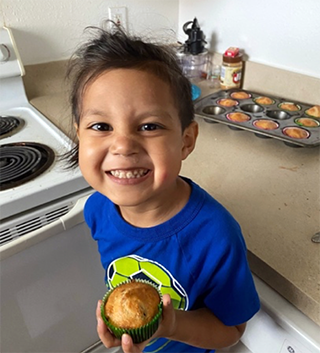
Bring your child into the kitchen to cook with you. Pick a family favorite or try something new. Cooking supports engagement with math, science, social studies, science and literacy.
As you measure ingredients together, count how much of each item you put in. Notice the ways each ingredient looks, smells, and even tastes, observe its color and texture. If you pick a dish that’s a family favorite, discuss what makes this recipe special to your family. You might even consider cooking a non-food item, like playdough, that can be used later.
— Elyse Ledford, Willow Classroom Teacher
Make an at-home obstacle course
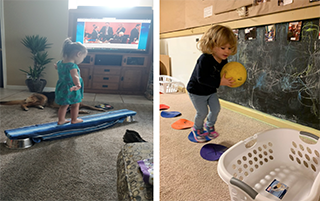
Create an obstacle course with safe household items like chairs, baskets, towels and
anything else you can think of. Practice words like “under,” “over,” “around,” “across”
or “fast and slow,” while giving one or two-step directions.
You can make this activity more challenging by having your child hold a ball or toy
to move across the course. This demonstrates gross-motor manipulative, balancing and
traveling skills.
— Keegan McKay, Willow Classroom Teacher
Step into nature while practicing writing
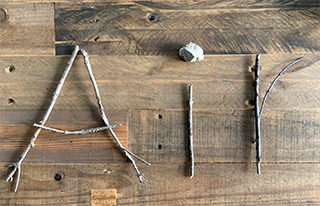
Explore the nature surrounding your house. What can you and your child find? Collect nature resources and use them to help your child write a word. Remember to only pick-up living things that naturally fell on the ground. If it is attached to a bush or tree, it is still growing and it will fall off on its own.
While creating letters with natural resources, children are demonstrating emergent writing skills and identifying letters. You’re also getting some fresh air together as a family.
— Eloah Decat, Holly Classroom teacher
Create a piece of art using natural materials from outside
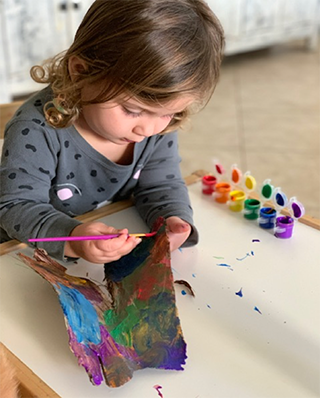
While looking for natural resources to write words, you can also search for pieces that can be part of artwork. You can draw, paint, cut or glue—be creative! What piece of art can you and your child make with things you find in nature?
Science and art come together when children explore the various ways, shapes and forms nature can collaborate with artistic representations.
— Meaghan Mosher, Holly Classroom teacher
Build a matching game to strengthen your child’s memory
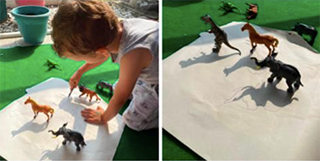
Let your child create their own matching game by drawing the shadow or outline of
different objects and then have them try to match what shadow or outline belongs to
each object. Children can use any toys they already have at home for this activity,
or use natural materials found outside such as rocks, sticks or shells.
This activity allows children to exercise their fine motor skills by drawing with
a writing utensil and creates the opportunity to learn about physics and the concepts
of light and shadow.
— Danielle Richardson, Maple Classroom teacher
Explore your child’s artistic side by creating patterns
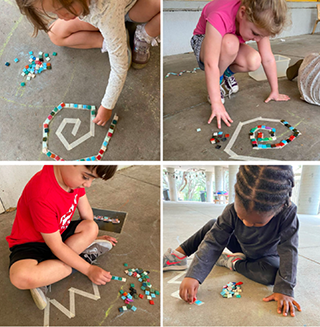
Engaging children in independent tasks leads to creativity and play-based learning.
Creating designs with painter's tape along with small manipulatives—such as bottle
caps, legos or buttons—allows children to interact with materials in a variety of
ways.
Children can make colors, sizes and shape patterns, and then count the total amount
of manipulatives it takes to create the design. This activity also gives them the
the opportunity to exercise their little fingers!
— Chrystyan Williams, Maple Classroom teacher
Practice counting skills using at-home staples
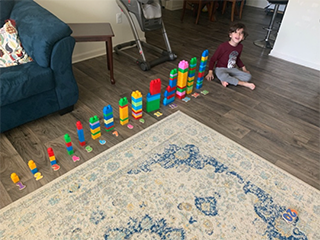
Math is all around us and can be naturally embedded into just about anything we do. At home, have your child use materials of their choice to incorporate math skills. Materials could include toys, natural materials or common household items. After choosing what items to use, have your child practice their number sense by representing the quantity of each material with its numerical value.
— Cassidy Dickson, Holly Classroom teacher
Recycle cardboard and fuel your child’s imagination
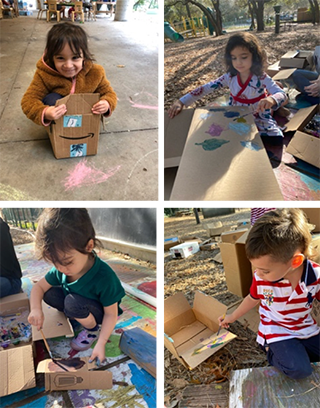
Let your imagination run wild and repurpose cardboard boxes! Engaging in imaginative play allows children to explore new ideas, develop oral language skills and take on different roles. Children can use a variety of art materials—such as paint, crayons, markers or chalk—to add details to their creation. Asking children questions while they are creating challenges their thinking and promotes a deeper level of learning.
— Jordan Simmons, Magnolia Classroom teacher
About the USF Preschool for Creative Learning:
The USF Preschool for Creative Learning (PCL) exemplifies an inquiry approach to teaching
and learning, innovating and improving early childhood education through teacher education,
research, and community engagement. The mission of the USF PCL is to provide a site
to demonstrate, observe, study and teach exemplary practices in early childhood education.
Learn more at www.usfpcl.org.